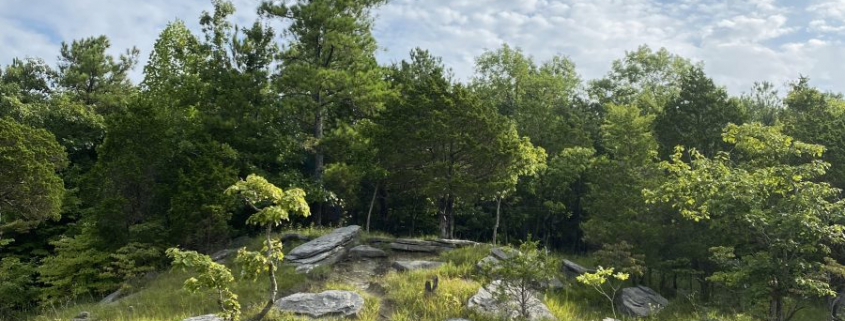Mid-August Hike Circuiting a Summit-Glade Racetrack
August 16, 2022, Jim Chamberlain, friend and fellow Nature enthusiast, and I hiked to and circuited the Racetrack Trail at Wade Mountain Nature Preserve, located just north of Huntsville, Alabama. This summit-top limestone glade is a climax plant community dominated by low growing herbaceous species and associated shrubs and trees. I had done little homework prior to our visit. The unique nature of the site and its vegetation took me by surprise. I will describe and explain as we proceed through this Post.
We entered the preserve via the trailhead below. We hiked to the summit racetrack through a typical temperate mixed pine and upland hardwood forest.
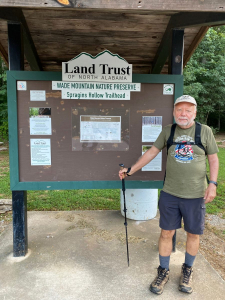
See my September 21, 2022 post on my hike through the mixed pine and hardwood forest: https://stevejonesgbh.com/2022/09/21/mid-august-hike-my-first-visit-to-wade-mountain-nature-preserve/
A Unique Ecosystem — A Special Floristic Community
My eyes opened a bit wider as we exited the more typical forest, transitioning to the glade. Certainly, we had ascended into a forest of fewer stems per acre and decreasing dominant crown height. Even at that, our entry to the glade seemed abrupt. Suddenly, the bright light of the opening pervaded. The path became a chalky, dusty near-white. Grass grew trailside and extended into herbaceous vegetation, brush, and scrubby forest.
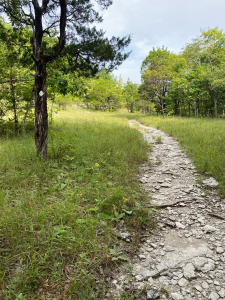
A Floristic Plant Ecology Study of the Limestone Glades of Northern Alabama, Jerry M. Baskin, David H. Webb and Carol C. Baskin (Bulletin of the Torrey Botanical Club, July-September 1995), described the kind of glade we encountered:
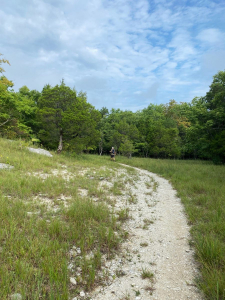
Lone cedars, in open-grown rounded form, punctuate the glade. I’m more accustomed to the closed canopies of our northern Alabama forests, accepting (no, welcoming and embracing) the glade’s open sky, bright light, and fresher air. Don’t get me wrong, I find no fault in the deep forest, yet, who among us does not like a change of pace?!
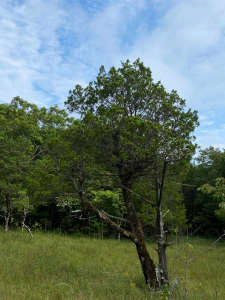
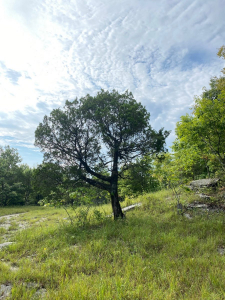
Near where we entered the glade, an abrupt summit of exposed limestone bedrock and scrub forest greeted us. It beckoned my camera lens, yet I did not truly appreciate the image and its power until I reviewed the photos back home. Although absent the lofty grandeur of my near-heaven memories of the Tetons, for example, this 1,020 rise warmed my soul and soothed my heart. The unique habitat under a gorgeous sky enveloped me in a spiritual aura when I studied and appreciated the image in my office. I know, all that sounds a bit mushy, but in this time of retirement, I believe I am due some escape to the side of sentiment and feeling. Observations on the science of this unique floristic community go only so far.
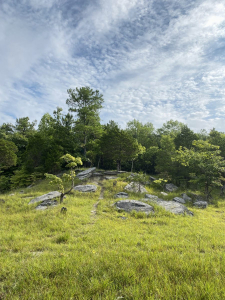
Here’s the two-and-a-half minute video I recorded near the summit: 2:36 video: https://www.youtube.com/watch?v=tLU17weMCaI
I must correct a term I used in the video narrative. I incorrectly termed the limestone glade a “bald.” Was that my first in-the-wild video narration error? No, nor will it be my last!
Part of the glade’s charm owes to encountering what I did not anticipate. I think of chinkapin oak as a lowland forest species, yet here it stood sapling-size, in bush form. In my riparian forest explorations I’ve seen chinkapin oaks approaching three feet diameter and reaching to better than 110 feet vertically.
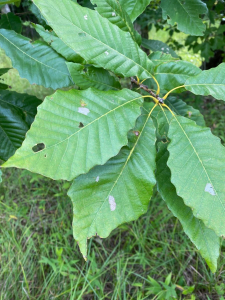
I am sure I would have discovered loads of unusual flora had I focused my efforts, especially had I been accompanied by someone more knowledgeable than I. Perhaps some day I can return in the company of one who knows this community and can lead me through a journey of comprehension and understanding. As with many of my Nature wanderings, on the glade, once again, I find out how shallow is my knowledge of our local and regional wildness. With my age and experience, the more I learn, the less I seem to know. I recall my early years of forestry practice when I thought I knew everything! The same is true of life.
Summer Wildflowers
The glade presented a nice palette of summer wildflowers, including this sunflower-like prairie rosinweed (flower left; leaves right).
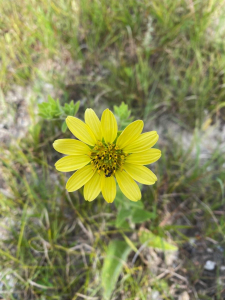
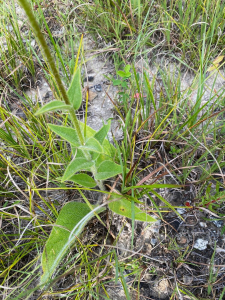
Less showy, yet more abundant, here’s roundfruit St. John’s-wort (flower left; leaves right).
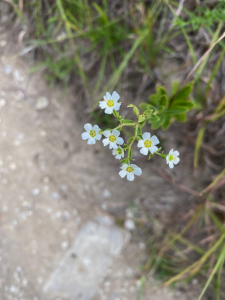
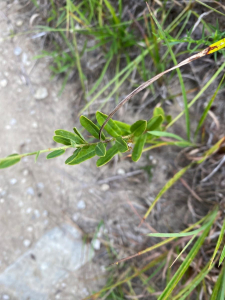
Carolina ruella brightened the rather drab grey of the chalky, pebbly soil surface.
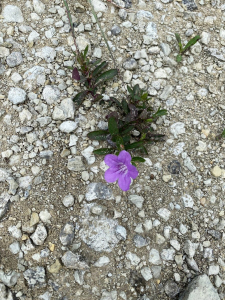
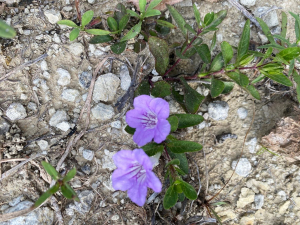
An online North Carolina Cooperative Extension publication provides a nearly lyrical description:
Ruellia caroliniensis, or Wild-petunia, is very common in North Carolina, found in lawns and woodlands. This native wildflower is so common that, despite its beauty, it is sometimes considered a lawn weed. This unbranched perennial can grow to 2 to 3 feet tall. Its leaves are light green and tend to have a crowded appearance. Its purple flowers bloom in spring, summer, and fall. The unstalked flowers are in axillary clusters of three to four and usually only one or two are open on any given day. Even though wild petunia’s flowers only last for a day, its long flowering period more than compensates. It seeds readily.
Yes, I found this species this year in May along Madison, Alabama’s Bradford Creek, evidencing its extended flowering season locally. The NC State reference added this note: Dry to moist forests and woodlands. Carolina ruella is apparently not picky about its preferred habitat!
We found lots of butterfly milkweed flourishing in this harsh, dry, exposed environment. Only one bore a full flower head. Again, in stark contrast to the chalky soil, the milkweed showed remarkable adaptability.
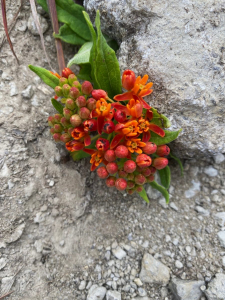
Two summers ago I purchased a small pot of butterfly milkweed from a nursery specializing in native perennial plants. It is thriving in my cultured garden with routine watering and occasional fertilization. Amazing that a plant can thrive across the range from a cultivated oasis to a barren glade summit.
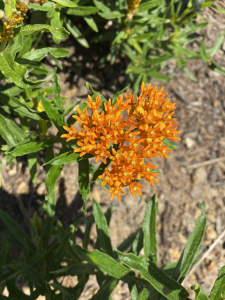
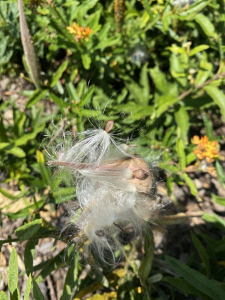
Prickly pear, unlike my preconceived notions for ruella and butterfly milkweed, seems perfectly suited to the glade.
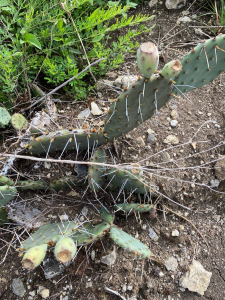
Scrub Forest Elements
Supplejack vine appears regularly during my bottomland and upland forest rambles. Here it is in the scrub forest within the racetrack, twining clockwise around a sapling (left) and around companion supplejack vines (right). Apparently, supplejack is an obligate clockwise climber. Oh, the ways of Nature!
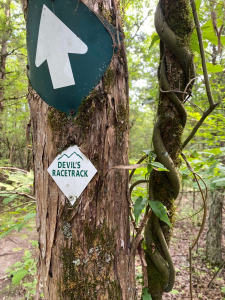
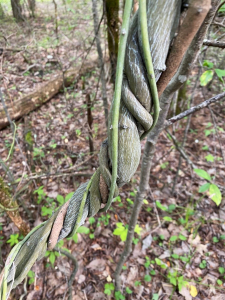
A sign that perhaps the devil (here at Devil’s Racetrack) himself posted! Why else would it be partially hidden among a foul mess of lichen, moss, and of all things, resurrection fern? I’m kidding, of course, about the foul descriptor. I find it, instead, whimsical — perhaps a creation of woodland fairies! I’d like to see it when rains refresh the fern.
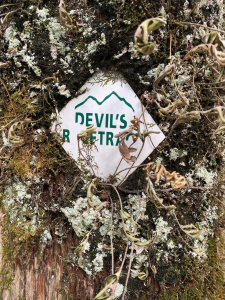
Not a whimsical creature, the bowl and doily spider waits for a hapless insect stops by for a snack. Well, not for a snack, but to provide a snack.
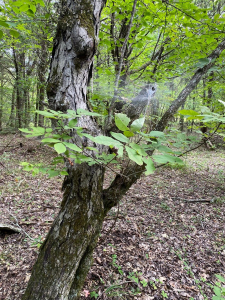
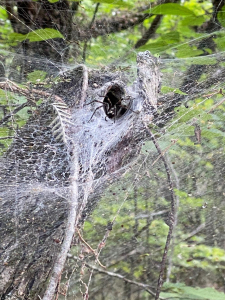
Mary Howitt began her epic The Spider and the Fly with words that touched us deeply as children:
‘Will you walk into my parlour?’ said the Spider to the Fly,
”Tis the prettiest parlour that ever did you spy;
The way into my parlour is up a winding stair,
And I have many curious things to show when you are there.’
‘Oh no, no,’ said the little Fly, ‘to ask me is in vain,
For who goes up your winding stair can ne’er come down again.’
And Howitt’s lesson ended with these unforgettable sentiments:
And now, dear little children who may this story read,
To idle, silly, flattering words, I pray you ne’er give heed:
Unto an evil counselor close heart, and ear, and eye,
And take a lesson from this tale of the Spider and the Fly.
Stated a bit differently, never accept candy from strangers!
Importantly, according the the Nature of things, spiders are no less noble or worthy than flies. There is no distinction of good and bad in Nature. Spiders are not evil, nor are flies angelic. The food chain is real; its a spider-eat-fly world. However, by no means are spiders apex predators. This doily spider has a bowl for a reason…an escape and shelter from the many critters that relish tasty arachnid treats!
Everything in Nature is connected to everything else. John Muir said it best:
When we try to pick out anything by itself, we find it hitched to everything else in the Universe.
Conservation and Utility
I try to avoid incorporating photos of human infrastructure, but I thought it added something to this Post. The Racetrack Trail meets the transmission line tangentially as it arcs (pardon the pun) across the northern extent of its circular transit (below left view to the west). After we departed the Wade Mountain trailhead, our route home transected the power line right-of-way a couple of miles to the west. The photo below right looks to the east at the north end of Wade Mountain, rising 300 feet above the photo point. I offer the two images only to provide some location perspective, and to evidence the intersection of utility (the power line) and conservation (the Nature Preserve).
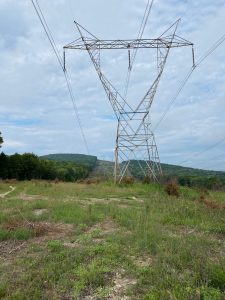
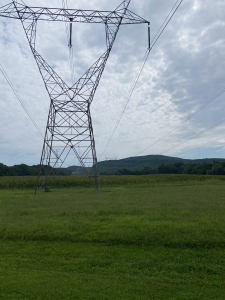
The interplay of utility and conservation does not create a cross-purpose paradox. Instead, the proximity demonstrates that conservation is not about protecting wilderness in an area that has long seen human interaction and disturbance. The Land Trust of North Alabama mission is direct and clear:
Our mission is to preserve North Alabama’s scenic, historic and ecological resources through conservation, advocacy, recreation and education.
The Wade Mountain Nature Preserve meets the spirit and intent of the critical mission!
Final Look at a Sacred, Spiritual Place
Here’s a repeat image of the special place…with its essence, spirit, and aura…on the Wade Mountain Nature Preserve Racetrack Trail.

Thoughts and Reflections
I offer these thoughts:
- Unique natural areas offer special rewards.
- Each place in Nature has a unique character and tells its own story.
- Inhale and absorb Nature’s elixir, especially when Nature offers unique treats!
Note: All blog post images created & photographed by Stephen B. Jones unless otherwise noted. Please circulate images with photo credit: “©2022 Steve Jones, Great Blue Heron LLC. All Rights Reserved.”
Another Note: If you came to this post via a Facebook posting or by an another route, please sign up now (no cost… no obligation) to receive my Blog Post email alerts: http://eepurl.com/cKLJdL
And a Third: I am available for Nature-Inspired Speaking, Writing, and Consulting — contact me at steve.jones.0524@gmail.com
Reminder of my Personal and Professional Purpose, Passion, and Cause
If only more of us viewed our precious environment through the filters I employ. If only my mission and vision could be multiplied untold orders of magnitude:
Mission: Employ writing and speaking to educate, inspire, and enable readers and listeners to understand, appreciate, and enjoy Nature… and accept and practice Earth Stewardship.
Vision:
- People of all ages will pay greater attention to and engage more regularly with Nature… and will accept and practice informed and responsible Earth Stewardship.
- They will see their relationship to our natural world with new eyes… and will understand more clearly their Earth home.
Tagline/Motto: Steve (Great Blue Heron) encourages and seeks a better tomorrow through Nature-Inspired Living!
Steve’s Three Books
I wrote my books Nature Based Leadership (2016), Nature-Inspired Learning and Leading (2017), and Weaned Seals and Snowy Summits: Stories of Passion for Place and Everyday Nature (2019; co-authored with Dr. Jennifer Wilhoit) to encourage all citizens to recognize and appreciate that every lesson for living, learning, serving, and leading is either written indelibly in or is powerfully inspired by Nature.
I began writing books and Posts for several reasons:
- I love hiking and exploring in Nature
- I see images I want to (and do) capture with my trusty iPhone camera
- I enjoy explaining those images — an educator at heart
- I don’t play golf!
- I actually do love writing — it’s the hobby I never needed when my career consumed me
- Judy suggested my writing is in large measure my legacy to our two kids, our five grandkids, and all the unborn generations beyond
- And finally, perhaps my books and Blogs could reach beyond family and touch a few other lives… sow some seeds for the future


All three of my books (Nature Based Leadership; Nature-Inspired Learning and Leading; Weaned Seals and Snowy Summits) present compilations of personal experiences expressing my (and co-author Dr. Wilhoit for Weaned Seals and Snowy Summits) deep passion for Nature. All three books offer observations and reflections on my relationship to the natural world… and the broader implications for society. Order any and all from your local indie bookstore, or find them on IndieBound or other online sources such as Amazon and LifeRich.

